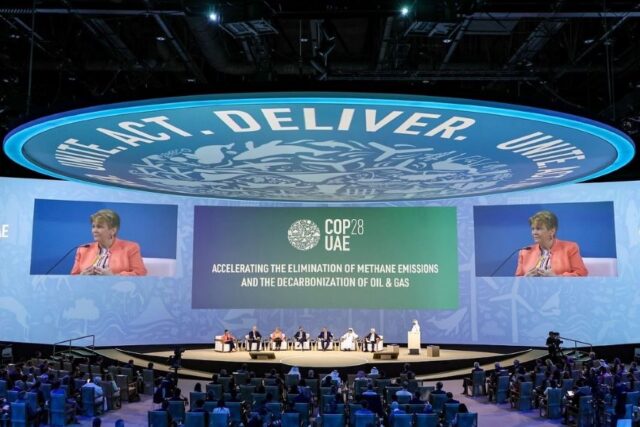…The world needs up to $3.5 trillion of additional investments each year to reach net-zero and restore nature
…Combined funding from business, government and philanthropic sectors is falling short, with 6% of 2025 investment needs met so far, and only 2% of philanthropic giving directed towards climate mitigation
…New report includes case studies on where these sectors have partnered to speed up financing, such as mangrove and land restoration, air quality improvement and the phasing out of coal with equitable and renewable outcomes
WED, DEC 13 2023-theGBJournal|Climate finance was central to discussions at COP28 in Dubai and funding to reach net-zero and restore biodiversity is still falling short.
New research highlights priorities for action and shows how partnerships between organizations from the philanthropy, private and public sectors can create a positive domino effect, cut emissions at speed and allow for a just transition.
Case studies of the report, developed in collaboration with McKinsey, include the global coalition Mangrove Breakthrough – securing the protection of 15 million hectares of mangroves worldwide – as well as the reshaping of land degradation in Latin America through Initiative 20×20 and the Breathe London project on enhancing air quality. Other proven partnerships include, the Energy Transition Accelerator in developing countries.
“For partnerships to work effectively, various stakeholders should be willing to come together to bring collective as well as individual expertise and resources to find solutions,” said Gim Huay Neo, Managing Director, World Economic Forum. “Without working with other partners to find the right intervention points, it is difficult for a single institution to deploy their funds.”
The transition to a net-zero economy presents a critical and necessary shift but is unavoidably costly. The financial gap lies in the extensive overhaul required in industries to adopt cleaner technologies and sustainable practices. The initial investments demand substantial funding, often beyond the capacity of many individual businesses or governments. Bridging this divide necessitates collaborative efforts and innovative financing models to mitigate risks and incentivize investments.
Joining private and public actors with philanthropic efforts offers a strategic approach to unlocking the transition to net-zero and restore nature. Philanthropy, with its nimble and risk-tolerant characteristics, plays a pivotal role in providing early-stage funding, catalysing wider investments while securing the most equitable outcomes.
The philanthropic-public-private partnership model uses the collective power of its members to bridge critical financing and knowledge gaps and generates capital structures that expedite a faster transition to sustainability. Examples of its use are already prominent. Over the past 20 years, more than 50 climate and nature-focused philanthropic-public-private partnerships have surfaced, indicating initial strides in addressing climate-financing hurdles.
Philanthropic-public-private partnership successes
With more than 40 partners, the Mangrove Breakthrough coalition is mobilizing $50 million-$100 million over the next 10 years to protect and restore mangroves worldwide. The decade-old Power Africa partnership – bringing together political leaders, private companies and financial institutions – has increased energy access to 37.5 million people across sub-Saharan Africa while closing on 14,000 megawatts of clean energy projects.
Some $2.5 billion in private capital has been pledged to support government initiatives through Initiative 20×20. Gathering 150 partners to reshape land degradation in Latin America and the Caribbean, the collaboration is propelling restoration efforts throughout the area, safeguarding and reviving over 50 million hectares.
Billions of dollars are being channelled through the multistakeholder initiative, Energy Transition Accelerator, that fast-tracks the shift to renewable energy sources in developing countries. The partnership assists nations in their energy transition strategies through a voluntary carbon market framework, while at the same time expanding energy access for people in poverty.
Philanthropic public-private collaborations are not bound solely to emerging economies. Breathe London is a collaborative initiative by the Clean Air Fund, Bloomberg Philanthropies, Clarity, the Mayor of London and local communities focusing on enhancing air quality. The initiative’s success has led to Breathe Cities, raising air-quality standards in cities around the world.
Bridging philanthropic, public and private efforts has proven powerful potential. Despite successes, new partnerships are often challenged when seeking to assemble and steer stakeholders, costing them significant time and resources. For an effective collaboration, philanthropic-public-private partnerships must be brought together under the right conditions with aligned objectives, a long-term perspective and a robust operational core.
The report’s Analytical framework guides partnerships based on their materiality, suitability and feasibility, having identified 31 intervention areas where joint action is set to accelerate high, scalable and immediate impact globally addressing 30% of emissions.
“Our research aims to support the creation, sustenance and scaling of these partnerships by exploring where to focus their efforts and how to ensure their success,” said Daniel Pacthod, Global Co-leader, McKinsey Sustainability. “We hope it gives them the confidence to partner with others for outsized impact and, crucially, save time in forming partnerships, as it’s time that we can scarcely afford to lose.”
New muscle for capacity-building
Giving to Amplify Earth Action (GAEA) – a World Economic Forum initiative – identifies, convenes and amplifies new and existing public, private and philanthropic partnerships for climate and nature.
Backed by 75+ partners of the world’s most important philanthropic partners, representing $12 billion/year of philanthropic capital, GAEA, operating in five climate crisis arrears (energy systems, nature, food systems, industry decarbonization, climate and health), is designed to streamline the process of forming partnerships, ultimately saving time and assets that are crucial in the global race against climate change.
X-@theGBJournal|Facebook-the Government and Business Journal|email:gbj@govbusinessjournal.com|govandbusinessj@gmail.com










